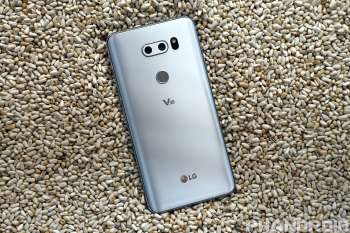
LG V30 vs Best Alternatives [SPECS]
The LG V30 is finally here, putting to bed all of the different rumors and leaks that have been coming out of the woodworks over the past few months. With the device’s arrival, we can now take a look at how the V30 stacks up against the competition.
The obvious device to take the V30 head on over the holiday season is the recently-announced Galaxy Note 8, and it seems that there won’t be too many differences at first glance. But we are also still expecting to see Apple’s latest creation, along with the Pixel 2 XL.
Advantages
The first big advantage when looking at other options on the market is the display size and overall dimensions. First, the V30 is .3-inches smaller than the Note 8, making it more manageable when interacting with the device. Gone is the secondary display, as LG has opted for the floating action bar, which removes the need for a secondary display altogether.
Speaking of that display, we see the return of the 2:1 aspect ratio which debuted on the LG G6 and then made its way to the likes of the Galaxy S8 and Note 8. This will definitely make for a more comfortable device while giving you more screen real-estate for viewing your favorite content.
Naturally, there will still be apps that can’t take advantage of the full 2:1 aspect ratio, but as more devices are released with this type of display, it’s only a matter of time before developers can take advantage. Regardless, the new display is definitely a welcome addition as LG opted to change the design of the LG V30.
While the V30 “only” features 4GB of RAM, there are two options for storage with either 64GB or 128GB. This can also be expanded by a microSD card slot, which is embedded into the SIM tray.
One lesser-known feature of the LG V series of devices has been its Hi-Fi DAC, and with the V30, we are greeted with a Hi-Fi Quad DAC.This DAC aims to bring a feeling like you are actually in the studio and offers a superior sound quality compared to the competition.
Finally, LG has kept with its recent run of dual-camera devices offering a 13MP and 16MP sensor on the rear of the V30. It seems that LG listened to those who purchased the LG G6, and opted to use a standard lens along with a wide-angle lens so that you can get more content in any of the images you’ll be taking.
Disadvantages
While the design change is definitely welcome for some of us, there are still others who wish that LG kept some of the staples of past V-series devices. The biggest of which is the removable battery, which is now gone from the LG V30. Instead, LG opted to use a more industrial design akin to the LG G6 with aluminum edges and glass found on the front and back.
Another disadvantage may be found for those who love to take selfies. Found with the V30 is a 5MP front-facing sensor which pales in comparison to the likes of the Galaxy S8, HTC U11, and even last year’s Pixel XL. Sure, selfies may not be for everyone, but if you love using Snapchat or Instagram, then you may be a bit disappointed here.
The other obvious disadvantage could come in the RAM management for the LG V30. Samsung packed 6GB of RAM into the Galaxy Note 8, which will definitely help the device sustain longevity before next year’s Note launch and beyond, but 4GB seems a bit small now. Luckily LG’s RAM management hasn’t taken a toll on the likes of the LG G6, so maybe things will play out just fine for the V30, but only time will tell.
Which is best?
While the LG V30 doesn’t pack a tremendous punch, it definitely seems that LG is taking the “safe” route with its 2nd-half flagship for 2017. We welcome the new design with open arms as the V30 introduces an IP68 rating, along with wireless charging, but we’ll have to see how well the device stands up against the test of time.
Let us know your thoughts on the LG V30 and if you’ll be looking to pick one up for yourself.